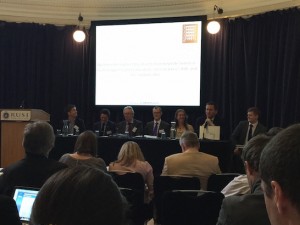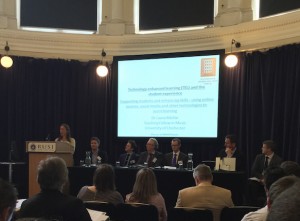Today I had the absolute pleasure of speaking at the Westminster Higher Education Forum Keynote Seminar event on ‘Technology in Higher Education ‐ best practice, skills and the student offer’, which was held in a lovely room in Whitehall, London. The morning was scheduled in two halves, each with keynotes followed by a panel of speakers and then questions. There was a very wide representation of the HE sector both on the platform and in the audience. The first session was hosted by Baroness Morgan of Huyton and the second session, where I spoke, was hosted by Lord Holmes of Richmond. He began the discussion by complimenting the delegates – that there were so many doctors in the academic audience and he had never begun a PhD…. but somehow I am sure that there were no other Paralympic Gold Medal winners in the room (let alone someone who had won Gold 9 times). He chaired knowledgeably and with grace.
My topic was:
Supporting students and enhancing skills ‐ using online sources, social media and other technologies to assist learning
and I had 5 minutes to cover it.
Here’s what I said:
My Lord, ladies and gentlemen, I am an advocate of technology in learning at the University of Chichester – from creating videos with Panopto, files on Moodle, to the material that I self-host as an Open Sourced Learning supplement to an undergraduate module about creating a curriculum, designed to connect students and engage them with their skills across a range of media and technologies.
Today’s learners do not need encouragement to engage with technology, it is every bit a part of the fabric of their lives, just like tea and toast. Universities provide VLEs or LMS- which could be Moodle, Blackboard, or any number of platforms. Academics sometimes refer to these as different to the World-Wide-Wilderness of the internet. The internal ‘walled gardens’ are intended to be a safe environment for students to interact and develop their learning.
So why are some students reticent to engage with an internal system and seemingly more ready to use something like Facebook, which has a wholly different purpose?
The underlying issues are not always obvious. With an internal platform, (hopefully) the institution is aware of the controls, of who can see files or posts, and as a result of this, where data posted might end up.
Wider social media sites are commercial enterprises and often we, the users, are the product. This does not mean that external sites cannot be used effectively to forward learning, but it does mean that people- students and educators- need to be aware.
I for one am not aware of all the repercussions and ramifications of the way my data is used when I post online. Finding out those details is difficult, and even more challenging is understanding the fine print. If you think you know what you ‘let out’ for the world, go to the website www.takethislollipop.com and see what it reveals. An unrestricted advocacy of using anything out there is at the very least misinformed and at worst can be honestly dangerous.
Data, security, and the morality of informed consent aside, why might students favour various platforms and how can we encourage engagement?
To answer this, I will draw upon my experiences over the last few months…
Where I worked with 5 students on a collaborative project separate from their coursework. To do this we formed a closed group on Slack, which is a team management tool for business. When we began, these students did not stand out as early adopters of online learning or new technologies- in fact, one had actively avoided the internet, but, with a purpose, they became driven to accomplish goals and learned to use technology to their advantage – Tweeting, posting blogs, even exploring Kickstarter. The various avenues helped them develop, reflect on, and take forward the skills learned in their Instrumental / Vocal Teaching Music degree, for example Pete gave online Skype sessions, Victoria made instructional videos, and Jess mentored an American high school student Omar, who wanted to learn to be a songwriter. The music profession is changing, the way young learners experience music is changing, and teachers need to move forward too. In those three months we collected over 4 hrs of audio, 50GB of video, and over 50K words of planning, and correspondence, not to mention the associated links, files, recorded Skype calls, and the deliverable of an accepted abstract to present about their collaboration and use of technology at the Researching, Advancing & Inspiring Student Engagement conference this September.
Beside the physical engagement and digital literacy, they have gained confidence and experience that extends beyond the walls of any classroom. This became vital when we made the online collaborations face-to-face with a visit to the people we had been working with, north of Los Angeles. A high point was recording Omar’s first original song, with vocals, guitar, and strings.
Has technology played a big role in this? Most definitely yes.
Facilitation, openness, and integration beyond the formal learning space has enabled the learning processes and the transition from learner to practitioner to unfold organically.
Going back to my earlier question of internal vs. external and engagement:
Having the capability to shape the learning landscape of the platform – to make it their own – impacted my students greatly. In my experience, a key ingredient to participation and engagement with technology in learning is having a genuine sense of collaboration – at all stages. This includes being a co-creator, co-author, and co-learner – and then the platform, along with all those who use it – both teachers and students, will come alive.
Photos taken by Roz Hall


